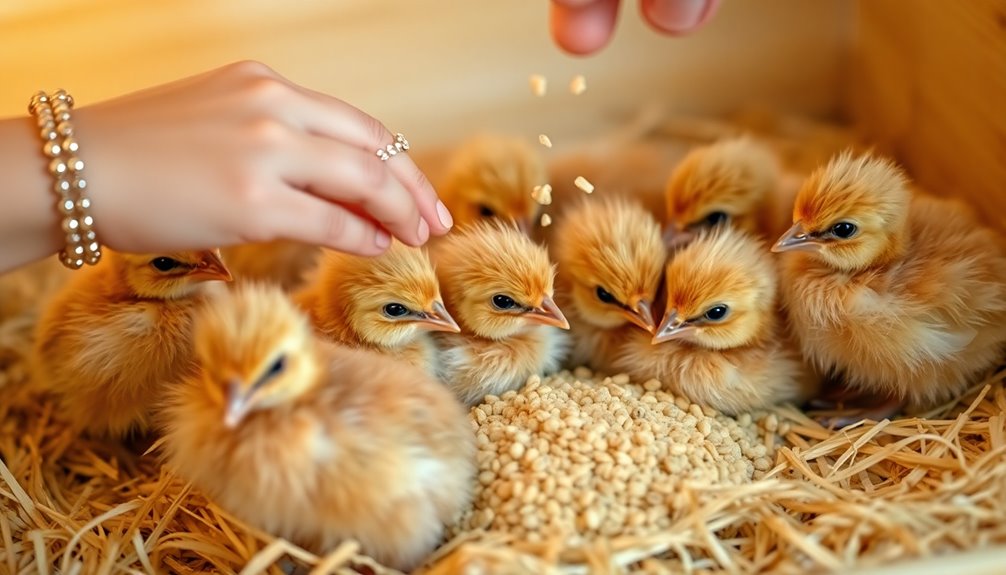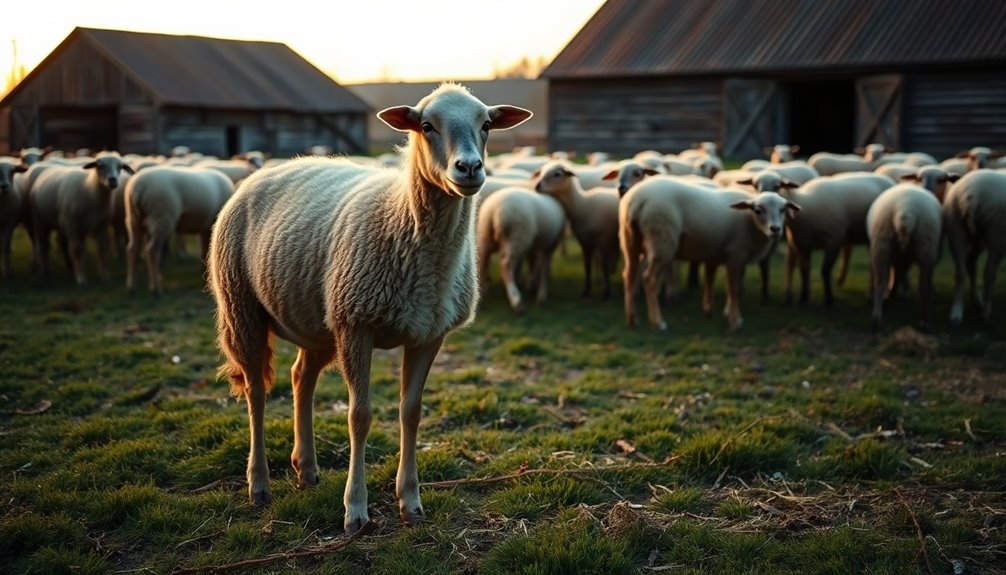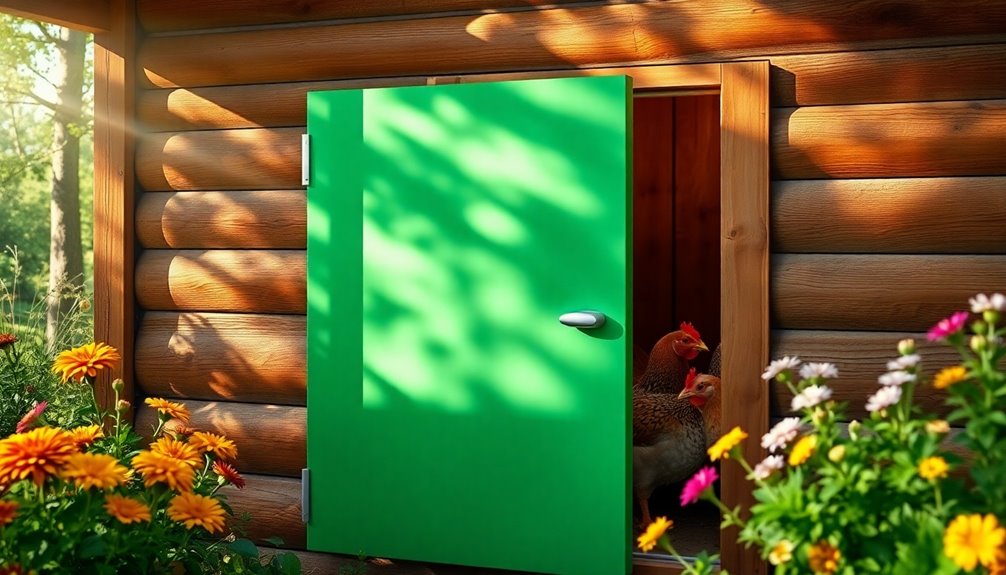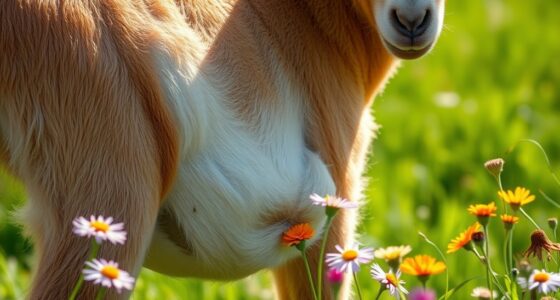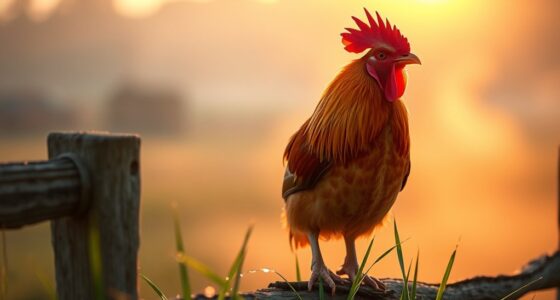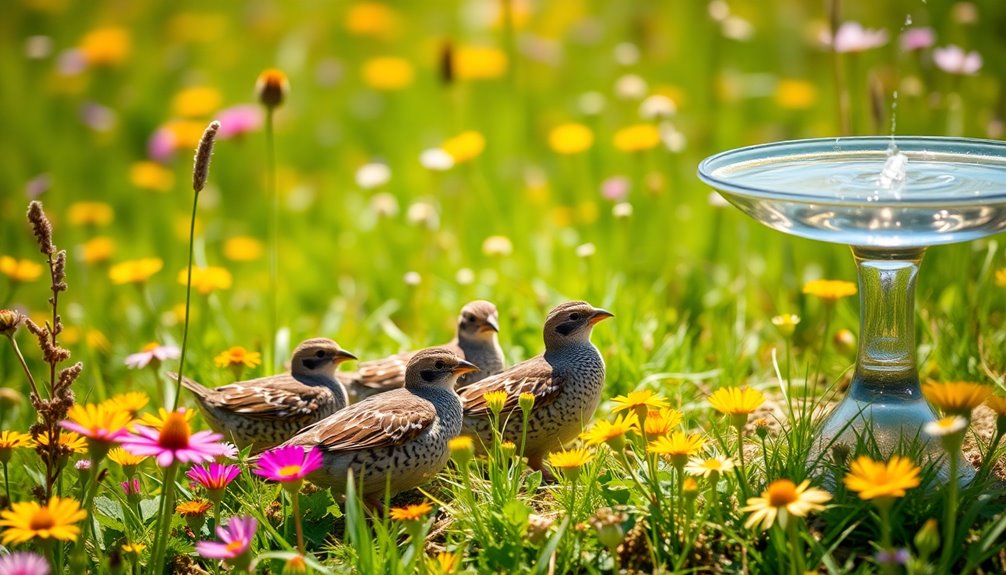To raise happy and healthy baby Coturnix quail, you need to create a safe and comfortable environment. Start with a brooder that offers 0.5 square feet per chick and maintain temperatures around 35°C (95°F), lowering it by 5°F weekly. Feed your chicks high-protein starter feed and keep fresh water available at all times. Make certain to provide enrichment activities like dust baths and treats to promote their well-being. Regularly check for health signs and maintain cleanliness in their space. There's so much more to discover about their care and development to guarantee they thrive!
Key Takeaways
- Start chicks on high-protein starter feed with 25-30% protein and ensure fresh water is always available for hydration.
- Maintain a draft-free brooding environment with an initial temperature of 35°C, decreasing weekly for comfort.
- Use shallow water dishes positioned away from heat sources and include pebbles to prevent drowning risks.
- Provide enrichment activities like dust baths and foraging treats to promote healthy behaviors and reduce stress.
- Recognize gender differences around 4-6 weeks for proper management; males have distinct coloring compared to females.
Understanding Coturnix Quail
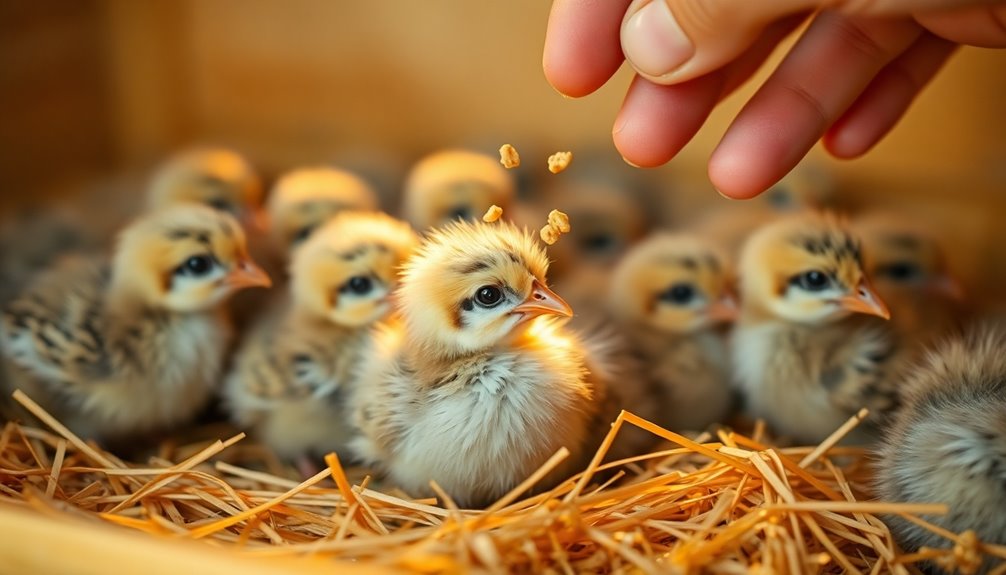
Coturnix quail, often referred to as Japanese quail, are small but remarkable birds that offer several advantages for both hobbyists and farmers.
These young quail mature quickly, reaching sexual maturity in just six weeks, which allows you to enjoy their incredible egg layers soon after. With an impressive annual production of around 300 eggs, they're a great choice for egg enthusiasts.
When you keep quail, you'll find they thrive in compact spaces, needing only 1 square foot per bird, making quail housing simple and manageable.
Their hardy nature enables them to adapt to various climates, although it's important to provide protection from harsh weather and predators.
Understanding these aspects can help you raise healthy and happy Coturnix quail.
Essential Housing Setup
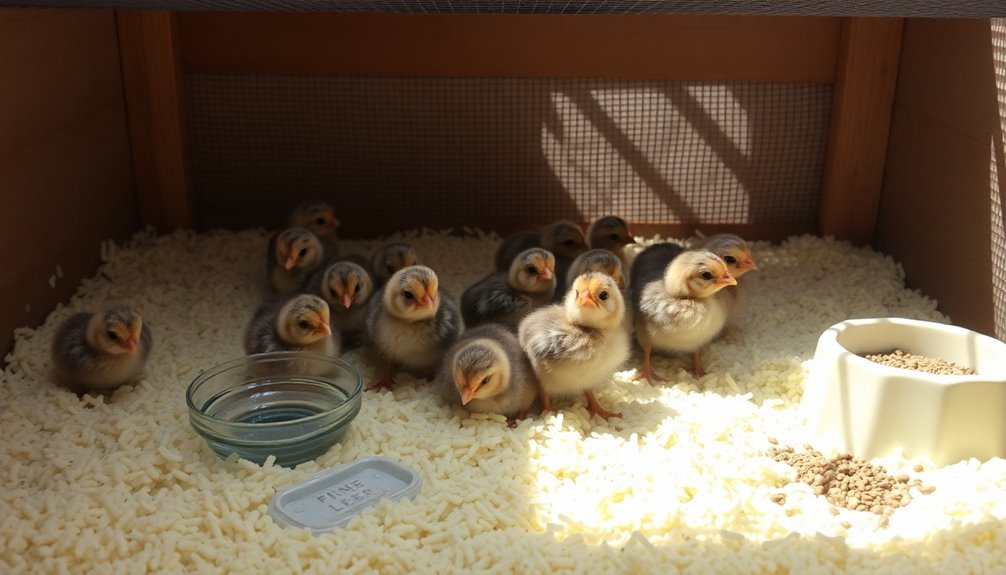
When setting up a housing environment for your baby Coturnix quail, it's important to guarantee a safe and comfortable space tailored to their needs.
Prepare a brooder with solid sides to minimize drafts, ensuring it offers about 0.5 square feet of space per chick. Include a wire mesh top for ventilation and safety.
Set the initial temperature at around 35°C (95°F) and reduce it by 5°F weekly as your chicks grow. Install thermometers in multiple areas for effective monitoring.
Provide a shallow water source, like a quail chick waterer, positioned 5-7 inches from the heat source to prevent drowning.
Regularly check on your chicks for health, quail food, and water, maintaining proper ventilation and cleanliness.
Proper Nutrition Guidelines
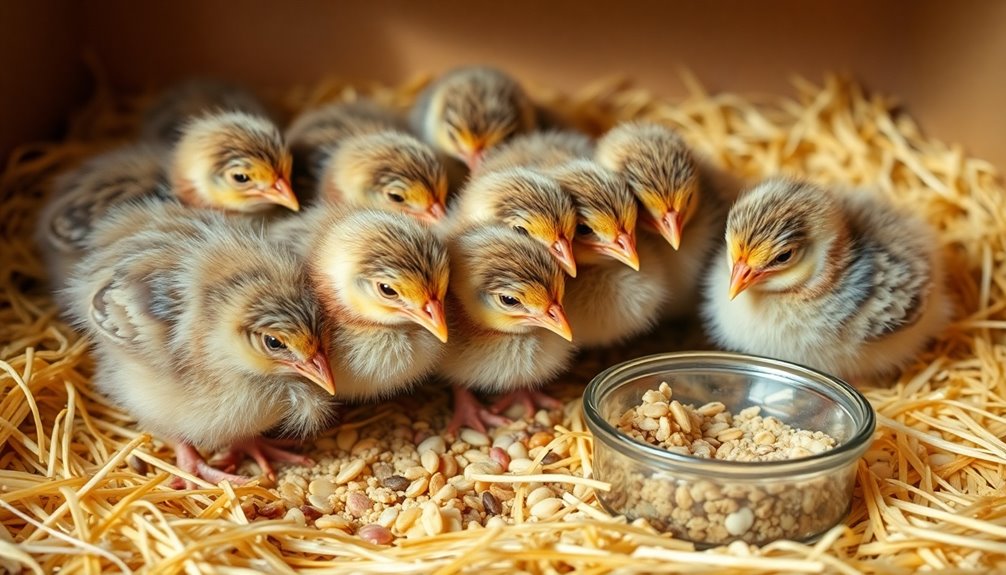
When caring for your baby Coturnix quail, proper nutrition is essential for their growth and health.
You'll need to provide a high-protein starter feed and guarantee they've access to fresh water at all times.
Balancing their diet with the right components will set them up for a thriving future.
Essential Protein Requirements
To guarantee healthy growth and development, baby Coturnix quail need a high-protein starter feed that contains 25-30% protein during their first 10 weeks. A quality Game Bird Feed, specifically formulated for quail chicks, is ideal.
Avoid using chicken feed, as it lacks essential nutrients and can hinder your quail's growth. In the first week, make certain the chicks have access to fresh water at all times.
Position the waterer 5-7 inches away from the heat source to encourage them to explore and hydrate. If you're looking for alternatives to Game Bird Feed, turkey grower feed can also work.
Safe Water Sources
Providing clean and fresh water is essential for the health and growth of baby Coturnix quail. To prevent dehydration, use shallow dishes or quail waterers, ensuring the water level is safe for the chicks. Regular tap water is suitable, but keep it clean and fresh at all times. Consider adding "magic water," a mix of garlic, apple cider vinegar, and honey, to boost their immune systems. Position the waterers 5-7 inches away from heat sources to encourage drinking. Monitor the water supply closely, as consistent access to hydration is vital for their development. Additionally, ensuring a clean water source helps prevent exposure to harmful pollutants, which can impact air quality and overall health.
| Water Source | Recommended Features | Benefits |
|---|---|---|
| Regular Tap Water | Clean, fresh, and cool | Prevents dehydration |
| Quail Waterers | Shallow, safe for chicks | Reduces drowning risk |
| Magic Water | Garlic, vinegar, honey mix | Boosts immune system |
Balanced Diet Components
Water isn't the only key to keeping your baby Coturnix quail healthy; a balanced diet is equally important for their growth.
Start with a high-protein starter feed containing 25-30% protein to support their rapid development during the first 10 weeks. You can create a homemade blend of balanced diet components by mixing 20% millet, 10% wheat, 10% dried insects, 40% game bird feed, and 20% turkey starter.
Always provide clean water in shallow dishes to prevent drowning. Introducing treats like mealworms can add variety, but remember, grit is needed for digestion.
You might also consider "magic water," made with garlic, apple cider vinegar, and honey, to boost their immune systems. Keeping them well-fed guarantees happy, healthy chicks.
Brooding Process Overview
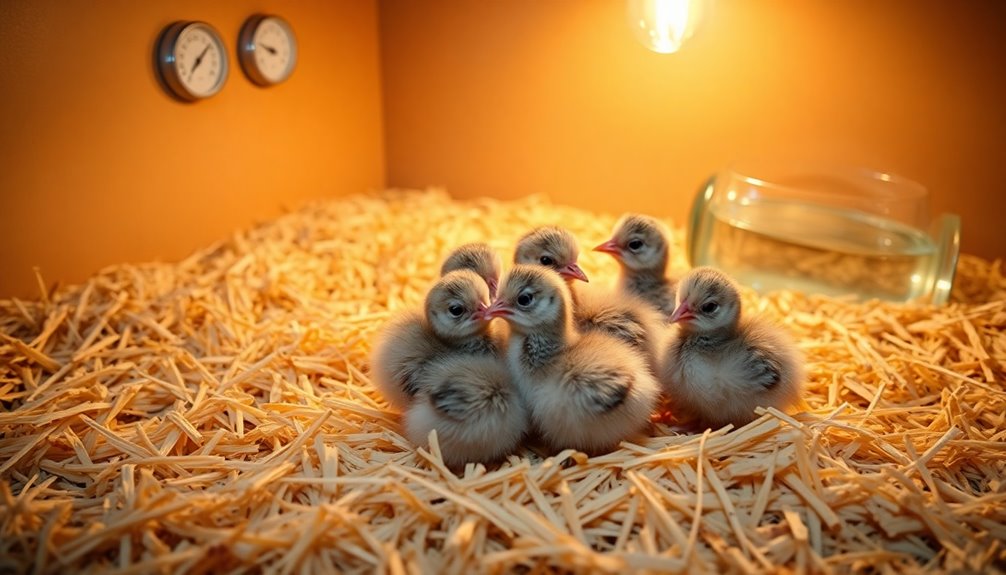
When brooding Coturnix quail, you need to focus on their timeline and preparation to guarantee a smooth shift from hatchling to healthy chick.
Keeping an eye on temperature and humidity is vital during the first few weeks, as these factors greatly impact their development.
Regular health monitoring and maintenance will help you create a safe and comfortable environment for your quail chicks.
Brooding Timeline and Preparation
Starting the brooding process for your Coturnix quail requires careful preparation and timing to guarantee the chicks thrive.
The brooding period lasts from hatching until they're 4-6 weeks old, so set up your brooder in a draft-free, climate-controlled area ahead of time. Layer fresh bedding on the bottom for warmth.
Begin with a brooder temperature of about 35°C (95°F), decreasing by 5°F weekly to assure the chicks grow comfortably. Regularly check on your quail chicks, keeping a close eye on their health, feed and water availability.
Implement a modified deep litter method by adding fresh bedding daily and performing full cleanings every 2-4 days to maintain hygiene until they're fully feathered and ready for relocation.
Temperature and Humidity Control
Maintaining proper temperature and humidity in your brooder is vital for the health and growth of your Coturnix quail chicks.
Start with an initial temperature of 35°C (95°F) and gradually decrease it by 5°F each week. During the first 14 days, keep humidity levels between 30-40%, increasing to 50-60% during the lockdown phase for ideal hatching conditions.
Regular monitoring of both temperature and humidity is important; improper levels can lead to a mortality rate of 5-10%.
Make certain your brooder is draft-free to protect your chicks from cold air, which can cause stress and hinder growth.
Use multiple thermometers to accurately gauge temperature variations in the brooder for consistent climate control.
Health Monitoring and Maintenance
Consistently monitoring the health and well-being of your Coturnix quail chicks is essential during the brooding process.
To guarantee their ideal growth and development, focus on these key areas:
- Temperature Control: Start at 35°C (95°F) and decrease by 5°F weekly, adjusting based on chick behavior to avoid stress from overheating or cold.
- Access to Food and Water: Regularly check that your chicks have constant access to fresh food and clean water, as this is critical for their health monitoring.
- Identify Common Brooding Problems: Watch for issues like splay legs or failure to thrive, and take prompt action to support their immune systems.
Temperature and Heating Needs
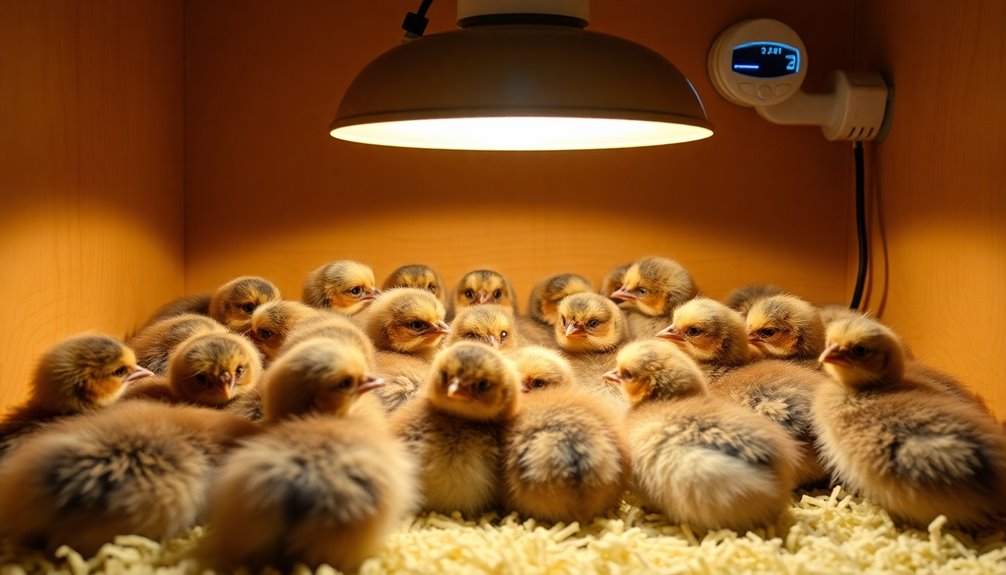
To guarantee your Coturnix quail chicks thrive, you'll need to provide the right temperature in their brooder.
Start with a temperature of 99°F and gradually decrease it by 0.5°F daily until the chicks are fully feathered, around three weeks old.
Keep a close eye on them; signs of cold stress include huddling near the heat lamp, while overheating manifests as excessive activity and moving away from the heat.
Proper heat control is vital, as improper temperatures can lead to increased mortality rates of 5-10%.
Make sure you have an adjustable heat source to accommodate your chicks' changing needs as they grow, ensuring a comfortable environment for their development.
Water Management Strategies
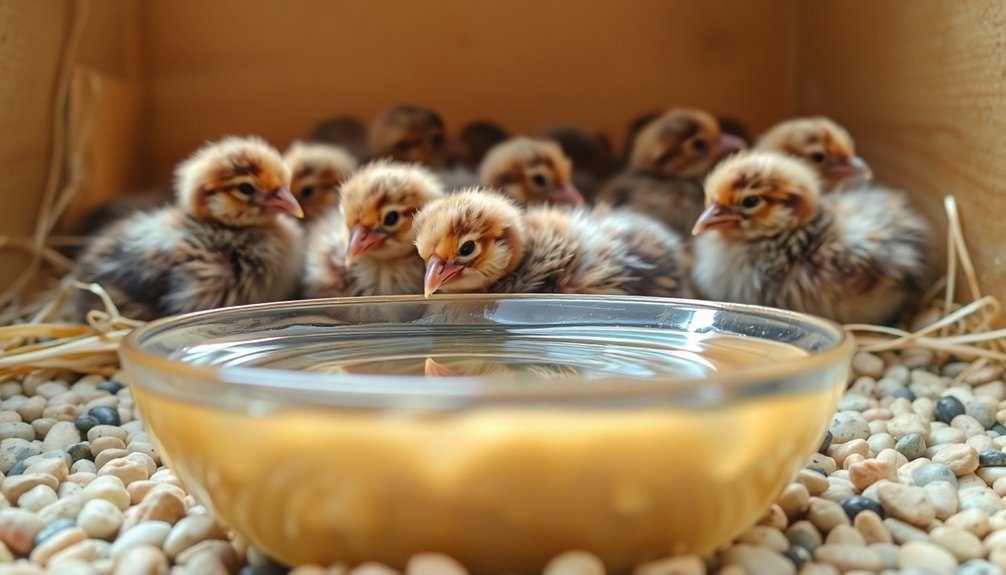
When it comes to keeping your baby Coturnix quail hydrated, you need to focus on accessibility.
Make sure to position water dishes for easy reach and establish a daily cleaning routine to maintain fresh water.
This way, you'll help prevent dehydration and keep your chicks healthy and happy.
Water Accessibility Options
Guaranteeing your baby coturnix quail have easy access to water is essential for their health and development. Here are some effective water accessibility options to take into account:
- Use shallow water dishes or quail-specific waterers: Place them 5-7 inches away from heat sources to maintain fresh, clean water and prevent overheating.
- Add pebbles or marbles: This keeps water shallow and reduces drowning risks for young quail.
- Strategically position waterers: Spread them out in the brooder to encourage exploration and healthy growth while monitoring for signs of overcrowding.
If you notice competition around waterers, adjust the number based on your chicks' population to guarantee everyone has access to the hydration they need.
Daily Cleaning Routine
Maintaining a clean water supply is key to your baby coturnix quail's health, and a daily cleaning routine helps achieve this.
Start by ensuring the water dishes are shallow and accessible, positioned 5-7 inches away from heat sources to encourage movement and drinking. Each day, monitor water levels and replace it with fresh, clean water to support proper hydration for your quail chicks.
Use a solution of 1 part vinegar to 3 parts water to sanitize the waterers, eliminating bacteria without harsh chemicals. Additionally, consider adding a "magic water" mixture like garlic or apple cider vinegar to boost their immune systems.
Prioritize hygiene by checking for contamination or debris to keep your chicks healthy and happy.
Health and Safety Practices
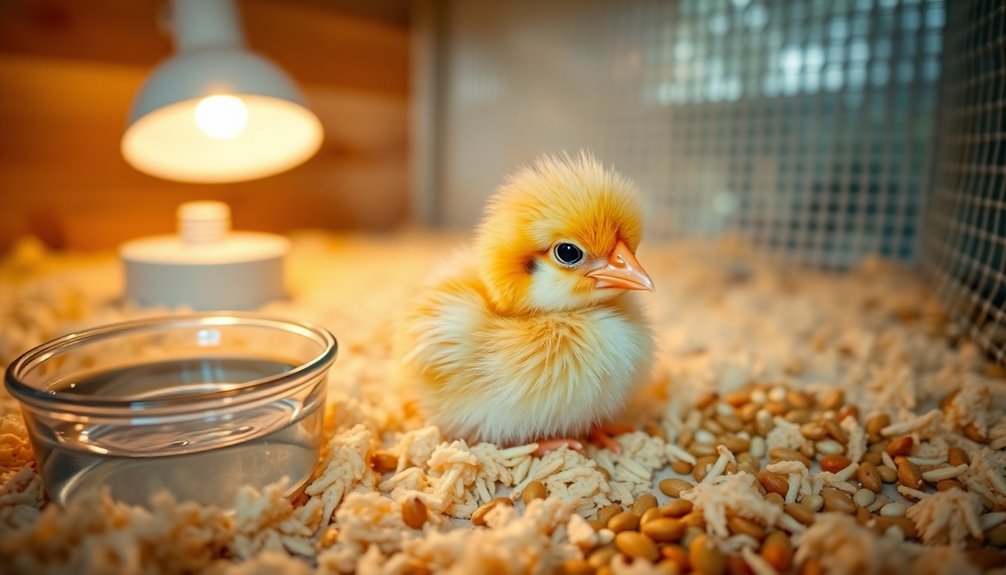
A clean environment is essential for the health and safety of your baby Coturnix quail.
Implementing effective health and safety practices will help prevent illness and guarantee your chicks thrive.
Here are three key practices to follow:
- Regularly clean brooders: Use the modified deep litter method, adding fresh bedding daily and performing full cleanings every 2-4 days to maintain a hygienic environment.
- Monitor temperature and behavior: Keep an eye on temperature fluctuations, signs of sickness, and aggression to address issues early.
- Limit exposure: Keep your chicks away from other animals and humans until their immune systems develop, reducing the risk of disease transmission.
Recognizing Gender Differences
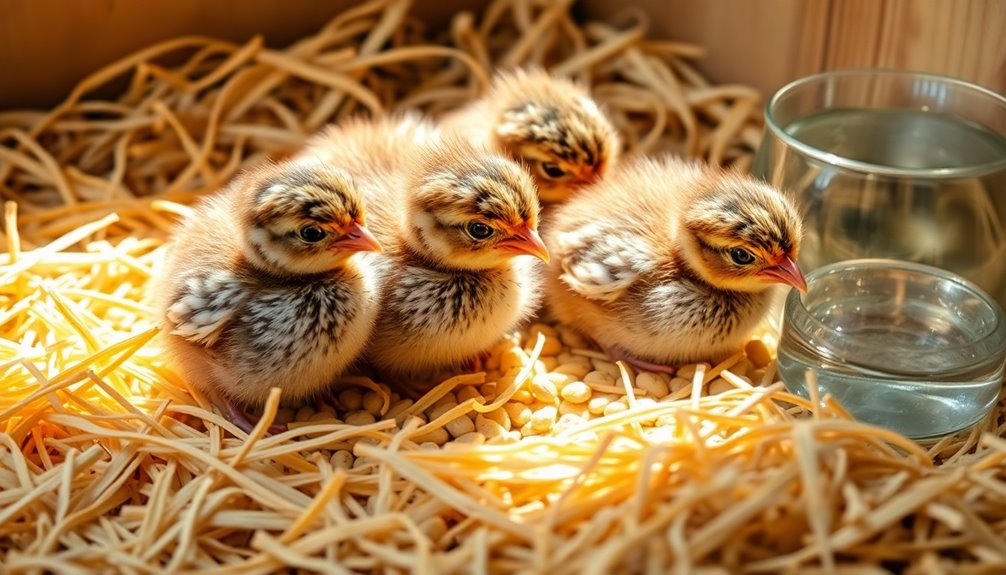
After you've established a safe environment for your baby Coturnix quail, recognizing their gender differences becomes a vital aspect of their care.
Males are identifiable by their distinct rusty-colored throat and chest, while females have a more muted sandy plumage. As they mature, sexual dimorphism becomes evident around 4-6 weeks, making it easier for you to identify the genders.
Males also display a dark patch on their breast and a noticeable white streak on their head, whereas females have rounded feathers.
In some color variations, vent sexing may be necessary for accurate identification, especially in younger chicks. Observing these plumage differences and physical characteristics is essential for distinguishing between males and females effectively.
Behavioral Enrichment Activities
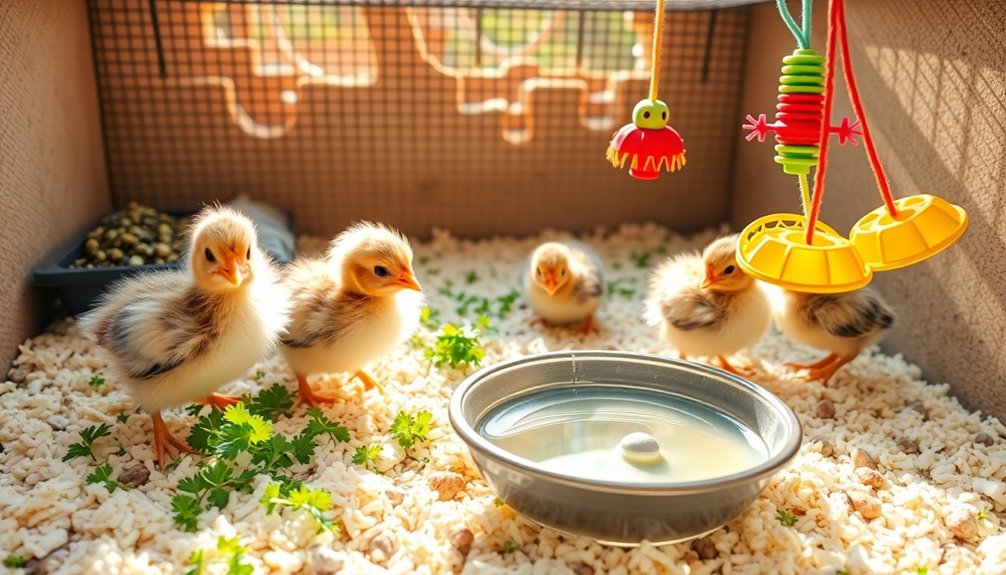
Engaging in behavioral enrichment activities is essential for the well-being of your baby Coturnix quail.
These activities stimulate natural behaviors and reduce stress. Here are three effective enrichment ideas:
1. Meal Worms: Offer freeze-dried mealworms as treats to encourage foraging and enhance interaction with your quail.
They'll love the challenge!
2. Dust Baths: Create a dust bath using fine sand or dirt.
This allows your quail to groom themselves, promoting feather health and happiness.
3. Garden Treats: Introduce small pieces of leafy greens or herbs as nutritious Garden Treats.
This not only engages them but also supplements their diet.
Common Challenges and Solutions
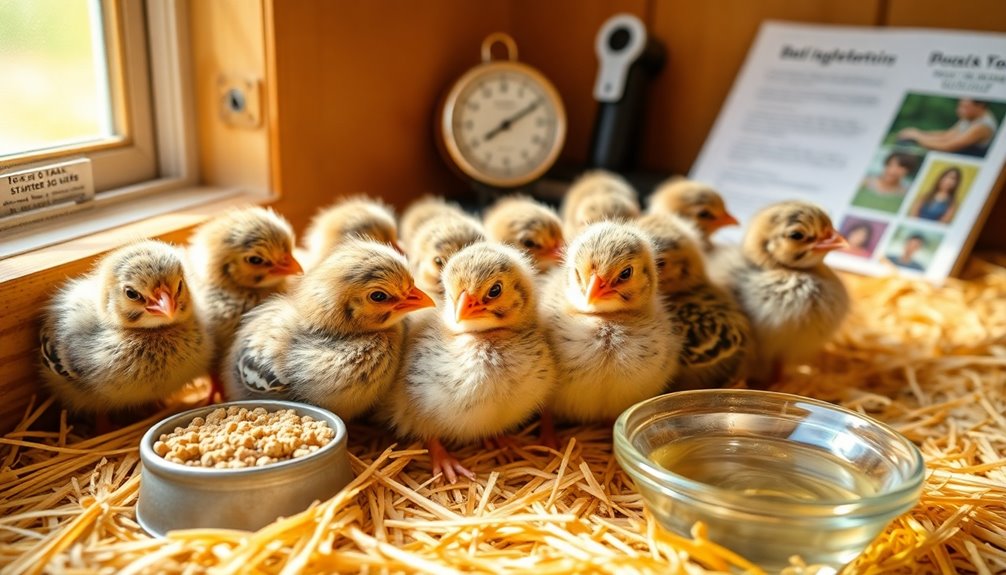
Maintaining a healthy and happy environment for your baby Coturnix quail can come with its challenges. To tackle common issues, keep an eye on temperature issues, ensuring it starts at 99°F and decreases daily. Overcrowding can lead to stress, so maintain a density of 6 quail per square foot, adjusting to 3-4 as they grow. Regular cleaning of brooders every 10 days is essential to prevent health risks.
| Challenge | Solution | Notes |
|---|---|---|
| Temperature Issues | Monitor heat sources | Look for huddling signs |
| Overcrowding | Adjust space as they grow | 6 per sq ft, then 3-4 |
| Aggressive Behavior | Separate aggressive males | Watch for fighting |
Frequently Asked Questions
How Do You Take Care of a Baby Coturnix Quail?
To take care of a baby Coturnix quail, start by setting up a brooder with a temperature of 35°C (95°F), gradually lowering it weekly.
Feed them high-protein starter crumble and provide fresh, clean water at all times.
Make sure they've enough space, beginning with 0.5 square feet per chick.
Keep an eye on their health, maintain good ventilation, and clean their bedding regularly to prevent disease.
Happy quails thrive in a clean, warm environment!
How Do I Keep My Quail Happy?
To keep your quail cheerful, create a cozy, clean, and spacious space.
Provide playful playthings like dust baths and delightful treats, such as mealworms.
Stick to a steady feeding schedule with high-protein crumbles for growth, and guarantee fresh water's always available.
Monitor the temperature, gradually decreasing it to maintain comfort.
Regularly interact with them to build trust and reduce stress, making your quail feel secure and satisfied in their environment.
How to Keep Quail Chicks Alive?
To keep your quail chicks alive, start with a warm brooder at 35°C (95°F) and lower it by 5°F each week.
Offer high-protein starter feed and guarantee fresh water's always available.
Watch for signs of distress, like huddling or excessive activity, which indicate temperature issues.
Avoid overcrowding by providing enough space, and keep the brooder clean by changing bedding regularly.
These steps will help your chicks thrive and stay healthy.
How Long Do Baby Quails Need a Heat Lamp For?
Baby quails need a heat lamp for about six weeks.
Start with a temperature of 99°F for the first week, then decrease it by 0.5°F daily.
By the time they reach 4-6 weeks old, aim for around 75°F.
Keep a close eye on their behavior; if they huddle, they're too cold, and if they move away from the heat, they might be too hot.
Adjust the lamp accordingly to keep them comfortable.
Conclusion
Raising baby coturnix quail can be a rewarding experience, especially when you provide the right care. Did you know that these quail can start laying eggs as early as six weeks old? By setting up a proper environment, ensuring proper nutrition, and addressing their health needs, you'll help your chicks thrive. Embrace the journey, and enjoy watching your happy, healthy quail grow. With the right tips, you'll become a successful quail caretaker in no time!

